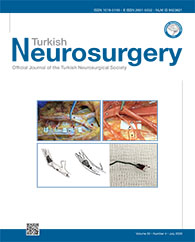2Arnavutkoy State Hospital, Department of Neurosurgery, Istanbul, Turkey
3Marmara University, Department of Biochemistry, Istanbul, Turkey
4Bakirkoy Dr. Sadi Konuk Research and Training Hospital, Department of Pathology, Istanbul, Turkey DOI : 10.5137/1019-5149.JTN.28793-19.6 AIM: To investigate the effects of tartrazine exposure on neural tube development, in early stage chicken embryos.
MATERIAL and METHODS: A total of 120 fertilized specific pathogen-free chicken eggs were divided into 4 equal groups (groups 1?4). After 30 hours of incubation, the eggs, except for the Group 1 (control group), were opened under 4X optical magnification. Group 2 was administered physiological saline. Group 3 was administered a middle dose of tartrazin (4.5 mg/kg) at a volume of 20 ?L by the in ovo method, and group 4 was administered a high dose of tartrazine (7.5 mg/kg) using the same process. Incubation was continued until the end of the 72nd hour; all embryos were then removed from the eggs and histopathologically examined.
RESULTS: Of the 120 embryos incubated, normal development and the closed neural tubes were shown in all embryos in group 1; 23 in group 2; 19 in group 3 and; only 9 in group 4. Open neural tubes were found in; 4 embryos in group 2; 5 embryos in group 3 and; 13 embryos in group 4. The neural tube closure defect was found to be significantly higher in group 4 compared to the other groups (p<0.01).
CONCLUSION: Based on our data, tartrazine, as one of the widely used food coloring agent, was seen to cause a neural tube defect in the chicken embryo model.
Keywords : Tartrazine, Neural tube defect, Chicken embryo, Food additive, Spina bifida




